
The history of ancient Israel and Judah begins in the Southern Levant region of Western Asia during the Late Bronze Age and Early Iron Age. "Israel" as a people or tribal confederation appears for the first time in the Merneptah Stele, an inscription from ancient Egypt that dates to about 1208 BCE. According to modern archaeology, ancient Israelite culture developed as an outgrowth from the Semitic Canaanites. Two related Israelite polities known as the Kingdom of Israel (Samaria) and the Kingdom of Judah had emerged in the region by Iron Age II.

The Philistines were an ancient people who lived on the south coast of Canaan from the 12th century BC until 604 BC, when their polity, after having already been subjugated for centuries by the Neo-Assyrian Empire, was finally destroyed by King Nebuchadnezzar II of the Neo-Babylonian Empire. After becoming part of his empire and its successor, the Persian Empire, they lost their distinct ethnic identity and disappeared from the historical and archaeological record by the late 5th century BC. The Philistines are known for their biblical conflict with the Israelites. Though the primary source of information about the Philistines is the Hebrew Bible, they are first attested to in reliefs at the Temple of Ramses III at Medinet Habu, in which they are called Peleset ; the parallel Assyrian term is Palastu, Pilišti, or Pilistu.
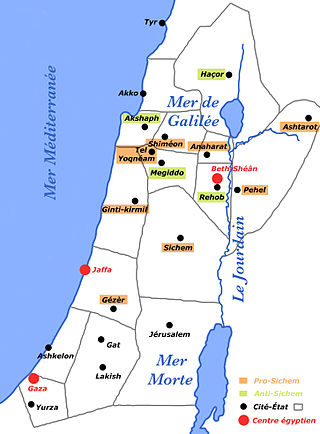
Canaan was a Semitic-speaking civilization and region in the Ancient Near East during the late 2nd millennium BC. Canaan had significant geopolitical importance in the Late Bronze Age Amarna Period as the area where the spheres of interest of the Egyptian, Hittite, Mitanni and Assyrian Empires converged or overlapped. Much of present-day knowledge about Canaan stems from archaeological excavation in this area at sites such as Tel Hazor, Tel Megiddo, En Esur, and Gezer.

The Sea Peoples are a hypothesized seafaring confederation that attacked ancient Egypt and other regions in the East Mediterranean prior to and during the Late Bronze Age collapse. Following the creation of the concept in the 19th century, the Sea Peoples' incursions became one of the most famous chapters of Egyptian history, given its connection with, in the words of Wilhelm Max Müller, "the most important questions of ethnography and the primitive history of classic nations".

Ekron, in the Hellenistic period known as Accaron was a Philistine city, one of the five cities of the Philistine Pentapolis, located in present-day Israel.

Tel Megiddo is the site of the ancient city of Megiddo, the remains of which form a tell, situated in northern Israel near Kibbutz Megiddo, about 30 km south-east of Haifa. Megiddo is known for its historical, geographical, and theological importance, especially under its Greek name Armageddon. During the Bronze Age, Megiddo was an important Canaanite city-state and during the Iron Age, a royal city in the Kingdom of Israel.
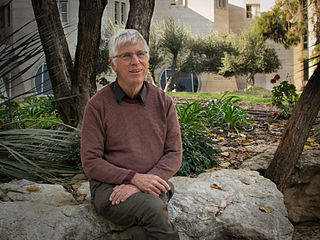
Amihai "Ami" Mazar is an Israeli archaeologist. Born in Haifa, Israel, he has been since 1994 a professor at the Institute of Archaeology of the Hebrew University of Jerusalem, holding the Eleazer Sukenik Chair in the Archaeology of Israel.

Tel Rehov or Tell es-Sarem, is an archaeological site in the Bet She'an Valley, a segment of the Jordan Valley, Israel, approximately 5 kilometres (3.1 mi) south of Beit She'an and 3 kilometres (1.9 mi) west of the Jordan River. It was occupied in the Bronze Age and Iron Age.

Israel Finkelstein is an Israeli archaeologist, professor emeritus at Tel Aviv University and the head of the School of Archaeology and Maritime Cultures at the University of Haifa. Finkelstein is active in the archaeology of the Levant and is an applicant of archaeological data in reconstructing biblical history. He is also known for applying the exact and life sciences in archaeological and historical reconstruction. Finkelstein is the current excavator of Megiddo, a key site for the study of the Bronze and Iron Ages in the Levant.

The United Monarchy in the Hebrew Bible refers to Israel and Judah under the reigns of Saul, David, and Solomon. It is traditionally dated to have lasted between c. 1047 BCE and c. 930 BCE. According to the biblical account, on the succession of Solomon's son Rehoboam, the United Monarchy would have split into two separate kingdoms: the Kingdom of Israel (Samaria) in the north, containing the cities of Shechem and Samaria; and the Kingdom of Judah in the south, containing the city of Jerusalem and the Jewish Temple. However, whether the United Monarchy actually existed is a matter of ongoing academic debate.

The Large Stone Structure is the name given to a set of remains interpreted by the excavator, Israeli archaeologist Eilat Mazar, as being part of a single large public building in the City of David, presumably the oldest settlement core of Jerusalem. Mazar tentatively dated the findings to the tenth to ninth century BCE. Mazar chose this particular name for the alleged structure because of its proximity to another site known as the Stepped Stone Structure. Mazar announced the discovery on 4 August 2005, and stated that she believed it may be the remains of King David's palace as recorded in the Books of Samuel. The interpretation of the remains as those of one single building, the suggested date, and the association with King David have all been challenged by other well-known archaeologists. The archaeological dig was funded privately by Roger Hertog, an American banker.

Gath or Gat, often referred to as Gath of the Philistines, was a major Philistine city and one of the five Philistine city-states during the Iron Age. It was located in northeastern Philistia, close to the border with Judah. Gath is often mentioned in the Hebrew Bible and its existence is confirmed by Egyptian inscriptions. Already of significance during the Bronze Age, the city is believed to be mentioned in the El-Amarna letters as Gimti/Gintu, ruled by the two Shuwardata and 'Abdi-Ashtarti. Another Gath, known as Ginti-kirmil also appears in the Amarna letters.

The Philistine language is the extinct language of the Philistines. Very little is known about the language, of which a handful of words survived as cultural loanwords in Biblical Hebrew, describing specifically Philistine institutions, like the seranim, the "lords" of the Philistine five cities, or the ’argáz receptacle, which occurs in 1 Samuel 6 and nowhere else, or the title padî.
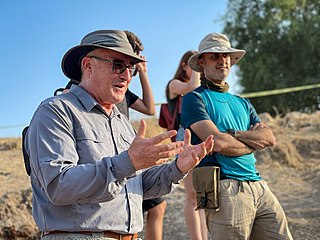
Aren Maeir is an American-born Israeli archaeologist and professor at Bar Ilan University. He is director of the Tell es-Safi/Gath Archaeological Project.
Seymour Gitin is an American archaeologist specializing in ancient Israel, known for his excavations at Tel Miqne-Ekron. He was the director of the Albright Institute of Archaeological Research (AIAR) in Jerusalem from 1980 to 2014.
The pottery of ancient Cyprus starts during the Neolithic period. Throughout the ages, Cypriot ceramics demonstrate many connections with cultures from around the Mediterranean. During the Early and Middle Bronze Ages, it is especially imaginative in shape and decoration. There are also many early terracotta figurines that were produced depicting female figures.

Cypriot Bichrome ware is a type of Late Bronze Age, and Iron Age, pottery that is found widely on Cyprus and in the Eastern Mediterranean. This type of pottery is found in many sites on Cyprus, in the Levant, and also in Egypt. It was typically produced on a pottery wheel. A large variety of decorations and motifs are attested. This pottery is very similar to certain types of the Mycenaean pottery from various locations.
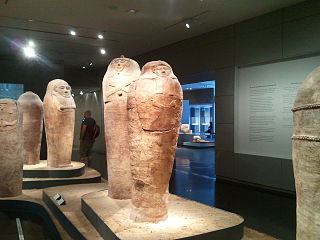
The anthropoid ceramic coffins of the Late Bronze Age Levant are a unique burial practice that is a synthesis of Egyptian and Near Eastern ideologies. The coffins date from the 14th to 10th centuries BCE and have been found at Deir el-Balah, Beth Shean, Lachish, Tell el-Far’ah, Sahab, and most recently in the Jezreel Valley in 2013. The coffins show Egyptian influence in the Ancient Near East and exhibit many Egyptian qualities in the depictions on the face masks on the lids. The lids can be separated into two artistic categories, the natural and grotesque, and the bodies are separated into type A, tapered from the shoulders, and type B, cylindrical. The graves contain wealthy funerary offerings from a variety of origins from Cyprus, Mycenae, Egypt, Phoenicia, and Canaan. The graves appear to be originally reserved for Egyptian officials and then later became a part of Canaanite and Philistine culture.

The Ekron Royal Dedicatory Inscription, or simply the Ekron inscription, is a royal dedication inscription found in its primary context in the ruins of a temple during the 1996 excavations of Ekron. It is known as KAI 286.
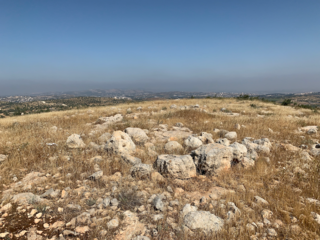
The so-called Bull Site at Dhahrat et-Tawileh, also spelled Daharat et-Tawileh, in the West Bank is an open air ancient cult installation from 12th-century BCE Canaan, where the bronze statuette of a bull was found. There is agreement that the statuette represents a sacred bull, but which god was represented by it is unclear. The statuette has been variously associated with the gods El, Baal, and Yahweh.


















